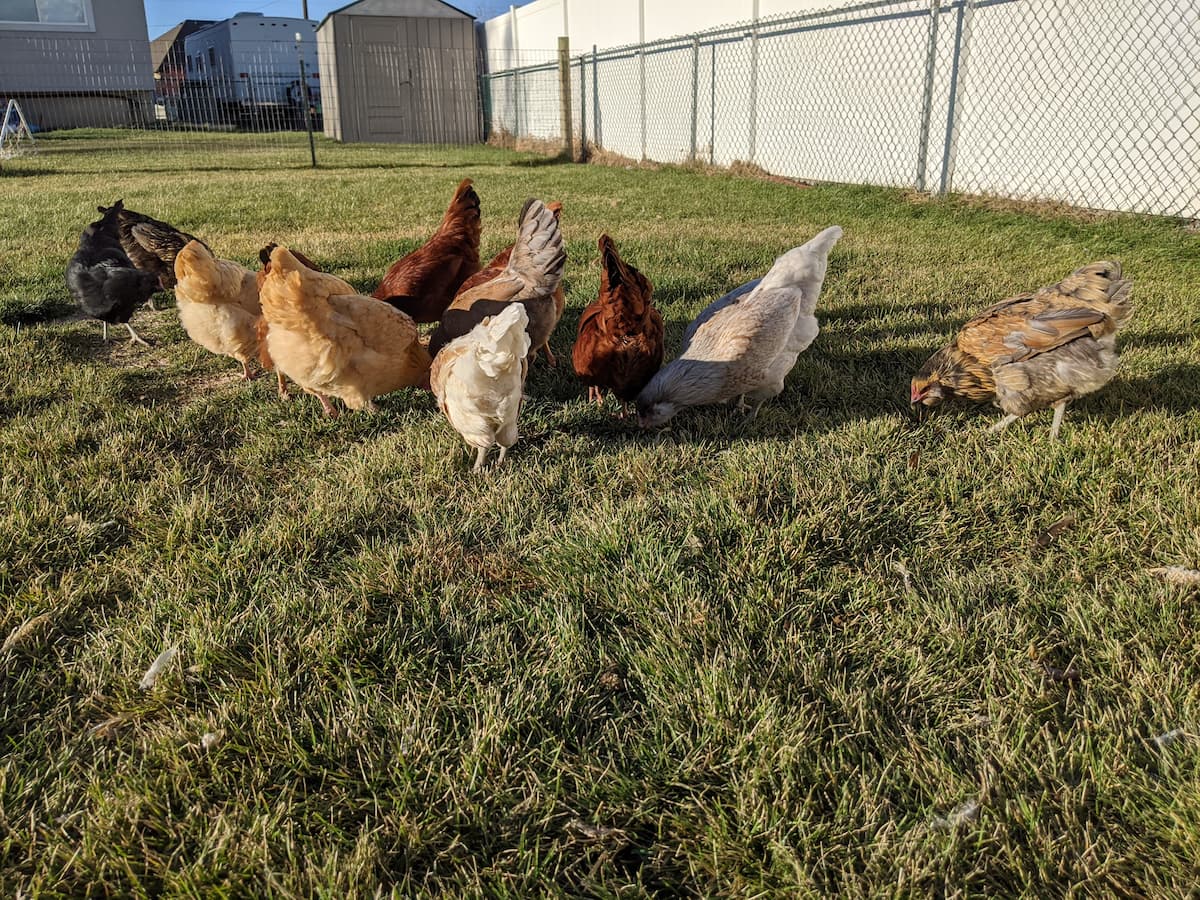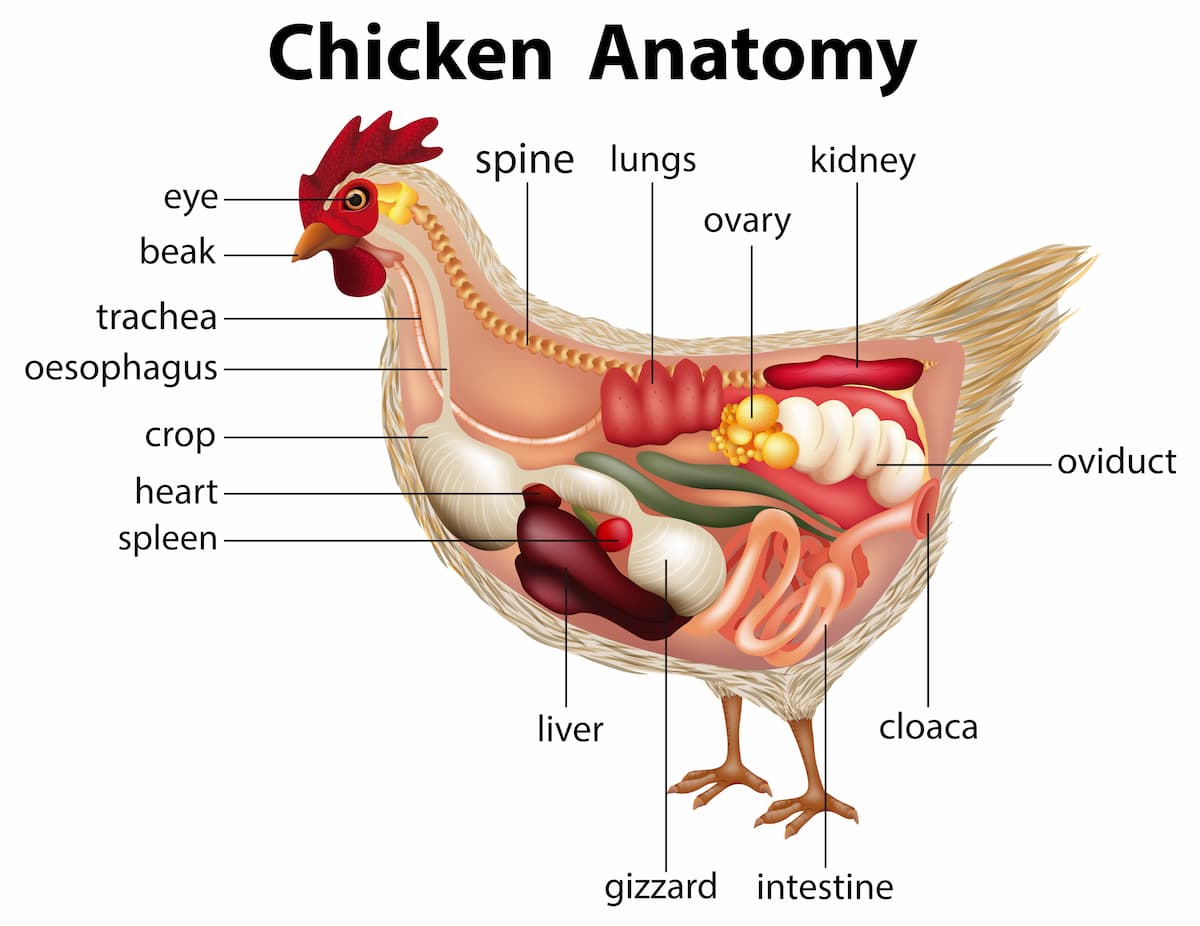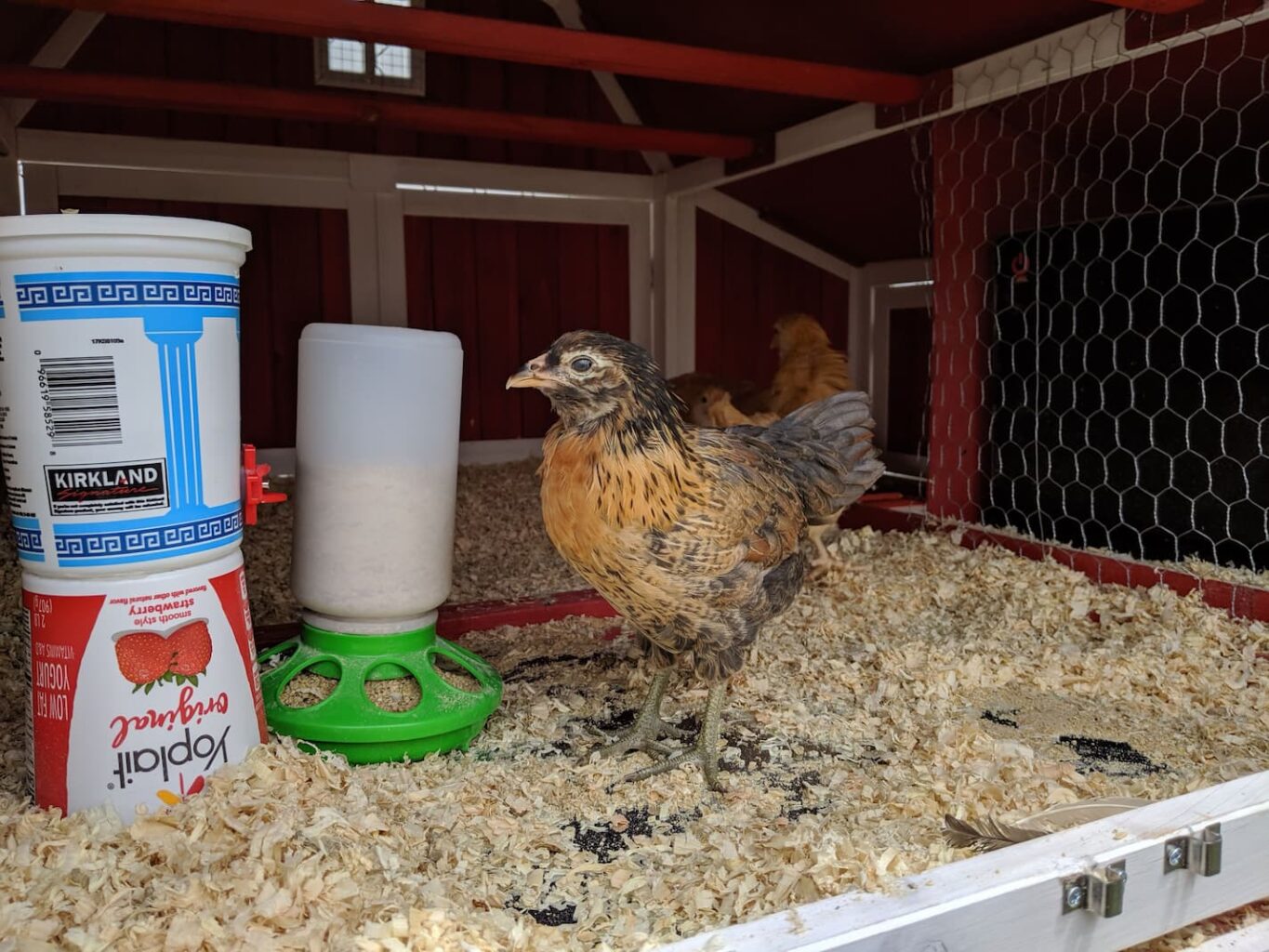I’ve seen my chickens eat some pretty crazy things – from the normal bugs and seeds to the stranger things like blades of grass, dirt, and even rocks. It stressed me out – until I remembered why chickens eat rocks, stones, and even dirt.
Chickens eat rocks, stones, and grit to aid in normal digestion. Chickens swallow food whole, as they lack teeth. The gizzard is a muscular stomach that pulverizes unchewed food. Food is ground up easier, faster, and with more energy efficiency in the gizzard with the help of grit.
In other words, grit can impact your chicken’s health, laying, and weight. So let’s dive into the research to find out all about grit for chickens.

Chickens Eat Rocks and Stones (Grit) to Help Normal Digestion
As weird as it can be to watch chickens eat rocks, (does anyone else has a mental image of Hei-Hei from Moana now?) it doesn’t mean that they’re lacking intelligence. In fact, it’s their natural way to work around the fact that they don’t have any teeth to mechanically grind up their food prior to digestion.
Let’s take a look at a chicken’s anatomy and natural digestion process – without doing any dissection. Instead, we’ll stick to a diagram.

When a chicken sees food, it chases it down and eats it – whole. A chicken’s beak, while efficient and amazing, doesn’t have teeth after all. All that beak can manage is a grab-and-swallow. If the food in question is a long blade of grass or a worm, then the chicken may have to tip its head back and swallow it more slowly – and in more tries.
However, even that isn’t actually chewing. Have you ever tried to swallow a long piece of spaghetti without swallowing it? It’s more like that – and it’s hard. But that’s how a chicken does it.
Once the chicken has swallowed their food, it goes into its crop. The crop is a temporary holding spot for their food. When it’s full, their crop sticks out and makes a chicken look like a lopsided bodybuilder who only worked on one pectoral.
Thankfully, food doesn’t stay in the crop for too long. From there, food goes into the gizzard – a more muscular stomach that will grind up whatever got swallowed.
However, the gizzard works best if it’s full of small rocks, stones, and grit. Based on my deep dive into crazy amounts of poultry research, here’s a cool quote that sums up what I found:
…the addition of granite grit to a practical type starting mash did not materially influence chick weight, but there seemed to be some improvement in feed efficiency. Bell and Simpson (1949) reported that grit-fed broilers weighed more and consumed less feed during a 9-week experimental period than did control birds without grit.
Heuser and Norris, 1946
In other words, grit helps a chicken chew up their food more efficiently. The gizzard could do it without any rocky help – but it would require more energy, time, and patience. And, well, chickens aren’t known for their patience. They’d rather eat a few, small rocks to make their digestion easier and more efficient.
But what is grit, exactly?
Grit for Chickens: What is it?
Grit can be anything that is small, rough, and not smooth. Common sources of grit include loose particles of sand, dirt, stone, crushed eggshells, and crushed oyster shell.
Chickens swallow these jagged pieces of stuff and let it sit in their gizzard to help break down food. Once the grit becomes too smooth or too small, it’s either regurgitated (like in the case of now-rounded stones) or it passes into the intestines and processed into chicken poop.
But what happens if a chicken doesn’t get grit supplied with its feed?
What Happens if Chickens Don’t Get Grit?
If chickens aren’t provided grit, it’s not necessarily a problem – provided that you know and do one of the following.
- Chickens that can free range in a large enough area (with a variety of terrain and access to bare dirt or soil) will find their own grit.
- Chickens that forage in the grass will make their own access to dirt by wearing down an area of grass to bare soil. They’ll do this to get access to grit and dirt baths.
- Chickens that are given mash-only styles of feed (and do not forage for food) may not need grit.
- Your chickens don’t have access to grit – but their feed has it included. More on this in a moment.
- Chickens that eat a variety of foods but don’t have access to grit will need it supplied either via sand, dirt, or a grit-specific supplement, like oyster shells (which is also a great way to introduce extra calcium if needed).
Of these, the most common options I saw in my research and in talking with other chicken owners is this: most chickens are kept in a coop with a run. And the run is often kept either on concrete or on compacted dirt. In these cases, you may not need to supply your chickens with grit – as long as you’re feeding them mash feed and not giving them too many treats that require a mechanical breakdown by the gizzard.
But what if you need to give your chickens grit? What’s the best kind to provide for them?
The Best Grit for Chickens
The best grit for chickens is what they’ll eat and what helps them be happy, healthy additions to your backyard homestead.
For us, the best grit for our chickens comes from two sources:
- whatever they forage from the yard. They’ve got bare dirt, pasture (grass), and a stony, sandy area to choose from for grit.
- crushed oyster shells kept in their run next to their feed. They’ve got free access to it for both grits and as a calcium supplement.
Some of the studies I read tried to see if there was a clear winner for grit. They tested various types of rocks, minerals, soil, and lots of other things. There wasn’t really a clear winner. Granite seemed to be a popular test subject. But again, there wasn’t a clear winner. Your chicken doesn’t seem to need a specific kind of grit – they just need grit.
So if you don’t have out specific kind of grit, don’t worry. Your chickens can find their own if they have access to bare soil. Or there are some feeds (and mashes) that are sold with grit included. Those feeds (and grit) are totally fine. Just make sure you double-check the package to see if that’s the case.
- Most chick feed, for example, comes with chick-sized grit – because chicks need smaller pieces of grit than adult chickens do.
- On the flip side, most layer feed doesn’t explicitly state that it comes with grit. In this case, your best bet is to put out some oyster shell (or crushed eggshell) supplement that will serve as both grit and a calcium supplement.
If your chickens don’t have access to bare soil for grit, then you’ll want to either provide grit or a source of soil/dirt/grit. When our run was on a concrete pad, we put a kiddie play pool with sandbox (play) sand in it. That way, they had access to grit and a dirt bath all in one.
Now that our chicken run is on a sandier, dirt spot (and it’s lined with copious amounts of chicken wire), we no longer have the kiddie pool full of play sand for them. They’ve got plenty of grit available already. And they also have ground oyster shells set out as an option, too.
Oh, and while I’d love to send you to a well-known online store for feed or grit (and earn a commission as an affiliate), please don’t order chicken feed from online – unless you absolutely have to.
You’ll get a far better deal from a farm store. I can get a 40-pound bag of layer pellets from my local farm store for about $15-20 and an oyster shell for less than $1 per pound, each of these prices depending on sales. A similar-sized bag of feed online costs closer to $40. That’s a huge difference! Find a local IFA, Tractor Supply, CAL Ranch, or another type of farm supply store by you. They’ll be able to get you much better pricing on feed, grit, and chicken treats.
Is Gravel Good for Chickens?
Gravel that’s useful for people (and/or landscaping) is generally too large for chickens to safely use as grit.
If you’d like to put out gravel for your chickens, or you’re adding gravel that they’ll have access to, then make sure that it’s gravel with the “minus” included. This means that the gravel also has all of the rock bits that are too small to be included as actual gravel. These “too small” pieces of gravel might be a better size for your chickens.
For example, when we built a gravel pad (to park our camper on), we bought “3/4-” (read as three-quarters minus) gravel for the pad. Our chickens don’t have access to this, so it’s not a source of grit for them. But the minus (smaller pieces of gravel) helps the gravel stay compacted better, too.
Or, to be safe, stick with sand, soil, and very small pieces of grit. Our chickens have access to sand-like what would go in a sandbox – and it’s worked really well for us.
Final Thoughts
Grit is important for chickens to be more efficient at digesting, but it’s not something to stress about. Really. Just make sure that your chickens have access to some bare dirt (or play sand) and/or some oyster shells. That’s generally more than sufficient.
Just know that some chickens (all of ours!) really like the oyster shell option – so it gets gone fast. We just make it a habit of picking up another pound or so every time we visit our local feed store. That way, it’s a cheap, easy way to make sure that our chickens have grit – and plenty of calcium so that we don’t get eggs with poor-quality shells. We still get eggs with ridges, but that’s not due to a calcium deficiency. That’s caused by stress – and you can read all about why chicken eggs have ridges in my other post here.
In any case, the oyster shell really is a cheap, easy, and fast option. It’s been our favorite one. And our children have decided it’s their job to keep the oyster feeder filled – which is awesome. Because teaching our kids to care for animals is one important reason we’ve got this backyard homestead.
So don’t overthink it. Go get some oyster shells, set it up, and enjoy your backyard chickens. Then, go check out our YouTube channel. I think you’ll like it.
Related Questions
Are Grits and Grit the Same Thing? Grits and grit are completely different. Grits are food (a porridge) from the American South made up of coarsely ground corn kernels. Grit is small, loose particles of sand, dirt, or stone.
Can You Feed Chickens Grits? Only feed chickens uncooked grits if they first have access to grit.
Can Chickens Live with Goats? Chickens can safely live with goats and share a pasture. For my best tips on keeping them together safely, read this post.

Resources
Learning from your own experience is essential, but learning from others is also intelligent. These are the sources used in this article and our research to be more informed as homesteaders.
- Balloun, S.L., and R.E. Phillips. “Grit Feeding Affects Growth and Feed Utilization of Chicks and Egg Production of Laying Hens.” Poultry Science, Elsevier, 11 Dec. 2019, www.sciencedirect.com/science/article/pii/S0032579119370312.
- Gastroliths, ucmp.berkeley.edu/taxa/verts/archosaurs/gastroliths.php.
- Gionfriddo, James P., and Louis B. Best. “Grit Use by Birds.” SpringerLink, Springer, Boston, MA, 1 Jan. 1999, link.springer.com/chapter/10.1007/978-1-4757-4901-4_3.
- Heuser, G.F., and L.C. Norris. “Oyster Shells, Calcite Grit, Ground Limestone, and Granite Grit in Rations for Hens.” Poultry Science, Elsevier, 11 Dec. 2019, www.sciencedirect.com/science/article/pii/S0032579119503005.
- Itani, and Khaled. “Eating Patterns of Broiler Chickens Fed Insoluble Grit, and Its Effect on Intake Variation, Retention Time, Performance and Gizzard Development.” Home, Norwegian University of Life Sciences, Ås, 2 July 2015, nmbu.brage.unit.no/nmbu-xmlui/handle/11250/286371.
- Kennard, D.C., and V.D. Chamberlin. Insoluble Grit for Chickens. 1959. https://kb.osu.edu/bitstream/handle/1811/62638/1/OARDC_research_bulletin_n0848.pdf.
- Scott, M.L., and G.F. Heuser. “The Value of Grit for Chickens and Turkeys.” Poultry Science, Elsevier, 11 Dec. 2019, www.sciencedirect.com/science/article/pii/S003257911937364X.
- Riedel, Bernard B. “The Use of Grit and Its Effect upon Ascarid Infections.” Poultry Science, Elsevier, 11 Dec. 2019, www.sciencedirect.com/science/article/pii/S0032579119510987.
